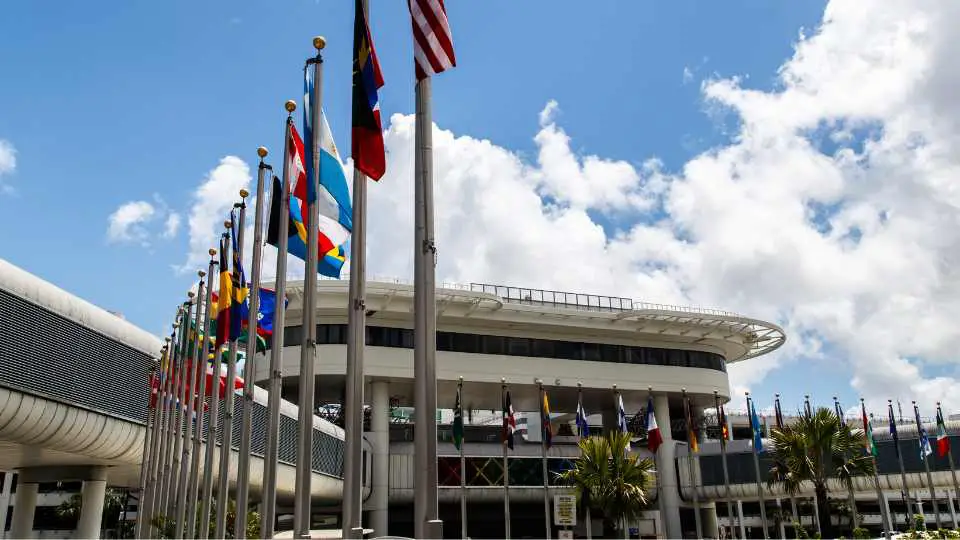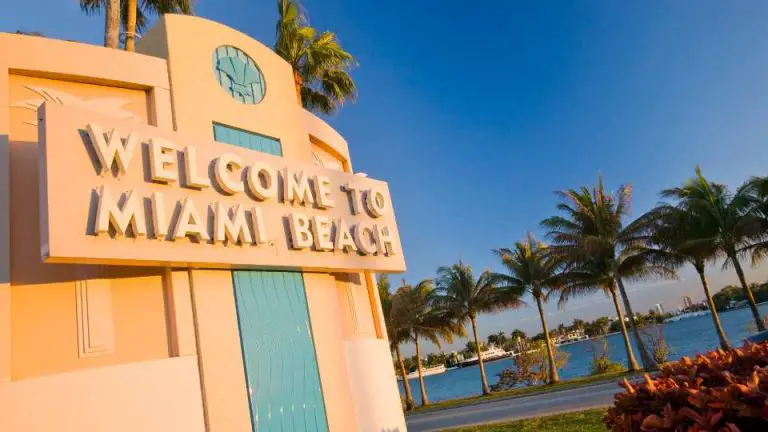Your Guide to International Airports in Florida: Gateways to the Sunshine State
Florida plays a pivotal role in international air travel in the United States with its multiple international airports serving as gateways to and from the region. These airports offer a broad range of services and have been designed to cater to the needs of millions of travelers each year.
The most frequented ones, including Miami International, Orlando International, Fort Lauderdale-Hollywood International and Tampa International, form the backbone of Florida’s air transport infrastructure. Miami International Airport, in particular, is known as a major conduit between the United States and Latin America.
Each Florida international airport brings its unique set of advantages, be it location convenience for tourists visiting attractions, amenities for business travelers, or accessibility for transit passengers. The facilities and services provided vary, offering travelers choices based on their preferences, with some airports undergoing continuous development and expansion to handle future travel demands. Information on airlines, flight availability, and on-ground services helps passengers in streamlining their travel plans.
Given the state’s popularity as a tourist destination and a hub for international business, easy air access not only bolsters tourism but also facilitates economic growth by connecting Florida to the rest of the world.
Overview of Florida’s Main International Airports
Florida is home to several key international airports, each serving as a significant hub for travel within the state and beyond. These airports facilitate millions of travelers annually and connect Florida to destinations across the globe.
Miami International Airport (MIA)
Miami International Airport (MIA) is not only the primary gateway to Latin America but also serves as one of the busiest airports in Florida. It is a major hub for international flights and, in 2019, Miami International Airport saw over 21 million enplanements, indicating its high traffic volume and strategic importance.
Orlando International Airport (MCO)
The Orlando International Airport (MCO) reigns as the busiest airport in Florida with more than 19 million enplanements reported in 2021. Located close to numerous famous attractions, MCO serves as a central hub for tourists and business travelers visiting Central Florida.
MCO also features a station for the Brightline high speed rail systems which connects to a number of destinations in southeastern Florida.
Fort Lauderdale-Hollywood International Airport (FLL)
The Fort Lauderdale-Hollywood International Airport (FLL) offers a wide range of international connections with a particular focus on travel to the Caribbean and Latin America. Among Florida’s international airports, it is recognized for its convenience and proximity to the cruise ports in Fort Lauderdale.
Tampa International Airport (TPA)
The Tampa International Airport (TPA) supports the West Coast of Florida and provides myriad domestic and international flight options. It is prized for its user-friendly design and seamless travel experience, efficiently handling passenger traffic and connecting Tampa with international destinations.
Southwest Florida International Airport (RSW)
Serving the Fort Myers region, the Southwest Florida International Airport (RSW) is an emerging international player, offering flights that connect travelers to major locations within the United States and a selection of international flights, primarily during peak tourist season.
Palm Beach International Airport
Although it’s less busy compared to other South Florida international airports, the Palm Beach International Airport offers its services with a focus on quality and comfort. It facilitates flights to destinations in Canada, the Caribbean, and beyond, catering to both locals and tourists visiting the Palm Beach area.

Secondary International Airports
Florida’s network of airports includes several secondary international airports that provide valuable services to regions outside the primary metropolitan areas. These facilities are essential for regional travel and offer international connections.
Jacksonville International Airport
Jacksonville International Airport (JAX) serves as a key transport hub for the northeast region of Florida. It provides travelers with both domestic and international flight options, focusing on giving access to major cities across the United States.
Orlando Sanford International Airport
Located in Sanford, near Orlando, the Orlando Sanford International Airport (SFB) mainly attracts leisure travelers heading to and from the city’s numerous theme parks and resorts. It is less congested than its counterpart, MCO, providing an alternative entry point to Central Florida.
Sarasota-Bradenton International Airport
The Sarasota-Bradenton International Airport (SRQ) caters to the west coast of Florida, namely the cities of Sarasota and Bradenton. As a smaller airport, it offers an easier and often quicker navigation experience through its terminals and gates.
Tallahassee International Airport
Tallahassee International Airport (TLH), located in Florida’s state capital, facilitates travel for government officials and residents. It includes several flights that connect the heart of Tallahassee to other major cities domestically and internationally.
Pensacola International Airport
Pensacola International Airport (PNS) stands as the main airport for Florida’s western Panhandle. It offers various services, including flights to major U.S. hubs that allow for further international connections.
Key West International Airport
Key West International Airport (EYW) connects the southernmost point of the continental United States to both national and international destinations. Despite its compact size, it efficiently manages the unique travel needs of Key West’s visitors and residents.

Differentiators Between Florida’s Airports
The international airports within Florida cater to distinct capacities, destination networks, and proximity to key attractions, offering varied options for travelers.
Airport Size and Capacity
Miami International (MIA) and Orlando International (MCO) stand out as the state’s busiest airports in terms of passenger volume. MIA serves as a major hub for flights to Latin America and Europe, whereas MCO, with its robust infrastructure, caters to a large number of tourists heading to Central Florida.
| Airport | Annual Passenger Volume |
|---|---|
| MIA | Over 45 million |
| MCO | Over 40 million |
| TPA | Over 21 million |
Tampa International (TPA) and the Southwest Florida International (RSW), while smaller in size compared to MIA and MCO, still provide substantial capacity to handle tourists and seasonal traffic effectively.
Destination and Airline Hubs
MIA is a major airline hub, especially for flights to the Caribbean and Latin America. It also hosts a wide variety of international airlines. MCO and TPA are hubs for domestic airlines with an increasing number of international flights. RSW, primarily catering to domestic flights, has been expanding its international reach.
- Miami International: Hub for American Airlines; focus on Latin America and Europe.
- Orlando International: Hub for several airlines; diverse destination map including Europe and Latin America.
- Tampa International: Focus on major US cities; selected international destinations.
Access to Tourist Attractions
Miami International provides the closest access to the vibrant cityscapes of Miami and beaches, as well as a gateway to the Florida Keys. Orlando International is the primary entry point for visitors to Walt Disney World and other major theme parks in the area.
- Proximity to Attractions:
- MIA: 13 miles to Miami Beach; gateway to the Florida Keys.
- MCO: 20 miles to Walt Disney World; serves other theme parks.
- TPA: Close to Tampa’s urban centers and beaches.
Both TPA and RSW offer convenient access to Florida’s Gulf Coast beaches, with RSW being strategically positioned for travelers heading to the Southwest regions of Florida.

Transportation and Accessibility
Florida’s international airports offer a variety of transportation and accessibility options catering to the needs of travelers. They ensure seamless connectivity from the airport to surrounding areas, integrating public transportation, rental car services, and linking with other transportation hubs.
Public Transportation Options
Most airports in Florida, including those with international status, are served by public transportation systems. For example, the Orlando International Airport allows travelers to connect with the city through buses and shuttles as well as the Brightline high speed rail service. The Fort Lauderdale-Hollywood International Airport is served by local buses, making it a public-use airport with easy access to the surrounding areas.
- Buses and shuttles
- Taxi and ride share services
- On-demand ride-sharing options
- Brightline high-speed rail service
Rental Car Services
All major airports in Florida provide rental car services, which are conveniently located either at the terminal or at a nearby rental car center. The Orlando International Airport features rental car facilities on Level 1, where travelers can directly rent a car from various providers.
- On-site rental car counters
- Direct access to rental vehicles
- Multiple rental car providers
Connecting Transportation Hubs
Florida’s airports serve as critical connecting nodes to other transportation hubs. The Fort Lauderdale-Hollywood International Airport received significant funding for improvements, enhancing its role as a transportation hub. Airports like the Tampa International Airport ensure their infrastructure supports smooth transitions for those requiring further connections, be it by road or other air services.
- Funded infrastructure improvements
- Integration with local transit systems
- Support for onward travel connections

Airport Amenities and Services
Florida’s international airports provide travelers with a plethora of amenities and services designed for convenience and comfort. From a wide selection of dining options to luxurious lounges, these airports cater to the needs of every passenger.
Restaurants and Retail
Most international airports in Florida boast an impressive range of restaurants and retail stores. For instance, Tampa International Airport (TPA) offers a variety of shops and restaurants, ensuring that passengers have access to both local flavors and international cuisine, as well as last-minute travel essentials and souvenirs.
- Shops: Duty-free outlets, gift shops, bookstores
- Restaurants: Fast food, sit-down eateries, coffee shops
Lounges and VIP Services
Florida’s airports do not skimp on lounges and VIP services providing travelers with quiet spaces equipped with numerous amenities. These facilities often feature comfortable seating, snacks, beverages, and sometimes even showers and business facilities.
- Lounges: Available in various tiers, from basic comfort to exclusive luxury
- Services: Concierge, priority check-in, and boarding
Hotels and Accommodation
Convenience is key for travelers, and many Florida international airports have hotels either on-site or in close proximity. For example, Miami International Airport (MIA) provides passengers with easy access to nearby accommodation, simplifying transitions between flights and rest periods.
- Hotels: Ranging from budget-friendly to premium
- Location: Typically within a short distance of the airport terminals

Airline Information
Florida’s international airports serve as hubs for a range of airlines, providing extensive flight options for both domestic and international travelers. They host major carriers and budget airlines, connecting passengers to destinations around the world.
Major Airlines Operating in Florida
Several leading airlines offer flights from Florida’s airports. Notably:
- American Airlines operates extensively in the region, providing flights to Latin America and the Caribbean.
- Delta Air Lines maintains a significant presence, with Atlanta being one of its top destinations due to its status as a major hub.
- Southwest Airlines is renowned for its domestic routes and customer-friendly policies.
Budget and Regional Carriers
Budget-conscious passengers have several options:
- Spirit Airlines is known for its cost-effective fares and operates numerous flights within the Americas.
- JetBlue offers competitive prices with a reputation for quality service.
- Allegiant Air focuses on serving smaller markets and regional destinations, often providing more direct routes.
Top Flight Routes and Destinations
Florida’s geographical location makes it a gateway to a variety of destinations. Some of the most frequented routes include:
- Miami International Airport serving as a major gateway to Latin America and the Caribbean.
- Direct flights to Atlanta, providing connectivity to one of the busiest airports in the world and further destinations domestically and internationally.

Visitor Information
Florida’s international airports offer comprehensive services to ensure that visitors have a pleasant experience upon arrival. They provide essential tourist information and access to the myriad of cultural and recreational activities available in the Sunshine State.
Tourist Facilities
Fort Lauderdale-Hollywood International Airport (FLL) and Southwest Florida International Airport (RSW) are equipped with visitor centers where tourists can obtain information about local attractions and accommodations. FLL is situated conveniently, offering travelers easy access to beaches and the famous Florida Keys. At the Lee County Visitor & Convention Bureau within RSW, tourists can interact with informed ambassadors ready to assist with travel plans.
- Fort Lauderdale-Hollywood International Airport Facilities:
- Visitor Information Center
- Easy access to Fort Lauderdale and Miami beaches
- Proximity to the Florida Keys
- Southwest Florida International Airport Facilities:
- Multiple VISIT FLORIDA-certified Visitor Information Booths
- Located near popular destinations such as Sanibel and Captiva Islands
Cultural and Recreational Activities
Florida’s international airports are gateways to cultural richness and recreational fun that the state is known for. Tourists can immediately start exploring various activities that range from the arts to adventure sports.
- Cultural Activities:
- Museums and galleries in nearby cities
- Local festivals and events celebrating Florida’s diverse heritage
- Recreational Activities:
- Beach activities including water sports, relaxation, and community events
- Trips to the Florida Keys for snorkeling, diving, and fishing expeditions
Each airport provides visitors with the necessary information to connect them with Florida’s abundant offerings, whether they are looking for relaxation on a sandy beach or an exploration of local culture.

Future Developments and Expansions
Florida’s international airports are seeing significant expansions and technological advancements aimed at meeting the growing demands of passenger travel and enhancing the overall travel experience.
Planned Airport Expansions
- Fort Lauderdale-Hollywood International Airport is poised to receive a substantial investment of $50 million, a reflection of the state’s commitment to enlarging its air transport facilities.
- Southwest Florida International Airport reported a record-setting 10.34 million passengers in 2022 and is undertaking expansion projects that embody the region’s response to increasing traveler numbers.
- In anticipation of future growth, Orlando International Airport is celebrating a new terminal and embarking on further expansion efforts. These developments are overseen by the Greater Orlando Aviation Authority, which is devoted to maintaining the airport’s status as a premier international gateway.
Technological Advances
Modernization is a key theme for Florida’s airports, with technological upgrades playing a pivotal role:
- Moving walkways are part of the upgrades planned for Orlando International Airport, streamlining passenger movement and improving efficiency within terminals.
- Innovations in passenger processing and security are also being integrated, reflecting a trend toward smarter, more connected airports. These advances support faster check-in and boarding processes, ultimately boosting passenger satisfaction and airport throughput.
Florida’s international airports’ expansions and technological enhancements are testament to the region’s proactive stance on embracing future travel demands while continually improving passenger experiences.






